Salzburg, the picturesque Austrian city, holds a complex history intertwined with the shadows of war. During the tumultuous years of World War II, this cultural gem endured the ravages of aerial bombardments, Nazi defenses, and the harsh realities of conflict. Yet, amidst the chaos, the city’s indomitable spirit shone through, as exemplified by the enduring Salzburg Festival. Today, visitors can explore the remnants of this turbulent past, uncovering the stories of resilience and sacrifice that have shaped Salzburg’s journey from devastation to liberation and recovery. The city’s wartime legacy invites deeper reflection on the lasting impact of global conflict and the human capacity for perseverance in the face of adversity.
Good To Know

- Salzburg’s strategic location on Mönchsberg made it a vital defense point during World War II, with an extensive network of bunkers and underground structures.
- The Salzburg Festival, a renowned classical music event, continued operation during the war, symbolizing the city’s cultural resilience in the face of destruction.
- Photographic documentation highlights the severe wartime devastation of landmarks like the Salzburg Cathedral, which suffered heavy aerial bombardment.
- The American memorial plaque at Toscanihof commemorates the liberation of Salzburg from Nazi occupation on May 4, 1945, honoring the sacrifices of American troops.
- The tour emphasizes Salzburg’s community resilience and the enduring human spirit as the city grappled with the chaos and challenges of the wartime era.
Tour Overview and Details
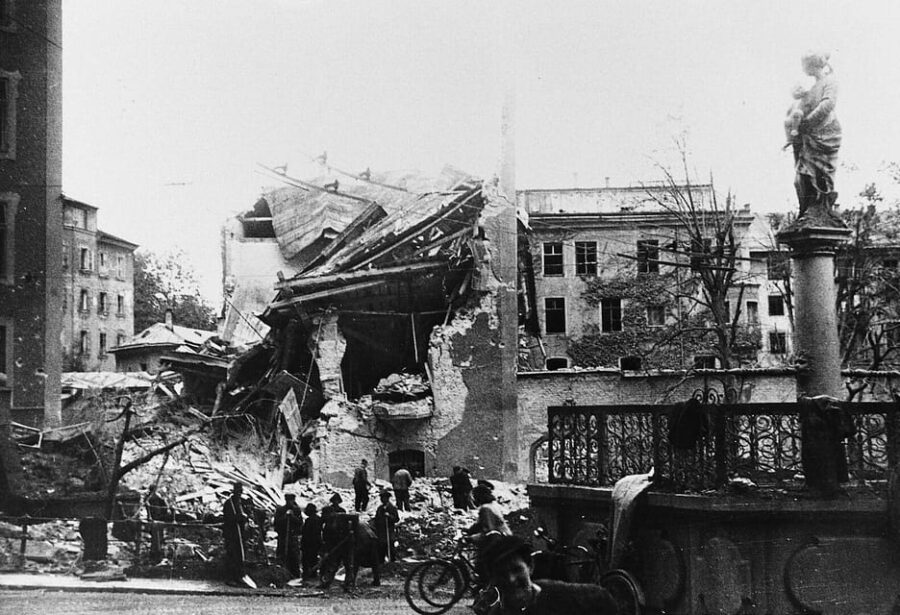
The Salzburg in the Shadow of War tour offers a 1.5-hour private group experience, priced from €6,321 for up to 30 participants and available in both English and German.
The tour is wheelchair accessible, with a free cancellation policy up to 24 hours in advance. Guests can reserve now and pay later.
The guided tour explores Salzburg’s key WWII sites, including Mozartplatz, the former USFA command center, Kapitel Square’s wartime ruins, and the Monchsberg’s bunker remains.
Participants will learn about the strategic importance of these locations and see photographic documentation of the city’s wartime destruction.
Led by official Austria Guide Sabine Rath, the tour provides immersive historical insights and captivating stories that bring Salzburg’s past to life.
You can also read our reviews of more tours and experiences in Salzburg.
Tour Highlights

Participants will start the tour at Mozartplatz, the former USFA command center during World War II.
They’ll then visit Kapitel Square, where they’ll see wartime ruins and historical photos of the damage to Salzburg Cathedral.
Next, they’ll explore the bunker ruins near Mönchsberg, a key defense point during the conflict.
The tour will also include a visit to the Toscanihof, where they’ll see an American memorial plaque commemorating the end of the war on May 4, 1945.
Throughout the tour, you will learn about the Salzburg Festival and its significance during the war years, gaining valuable insights into Salzburg’s rich history.
Historical Insights
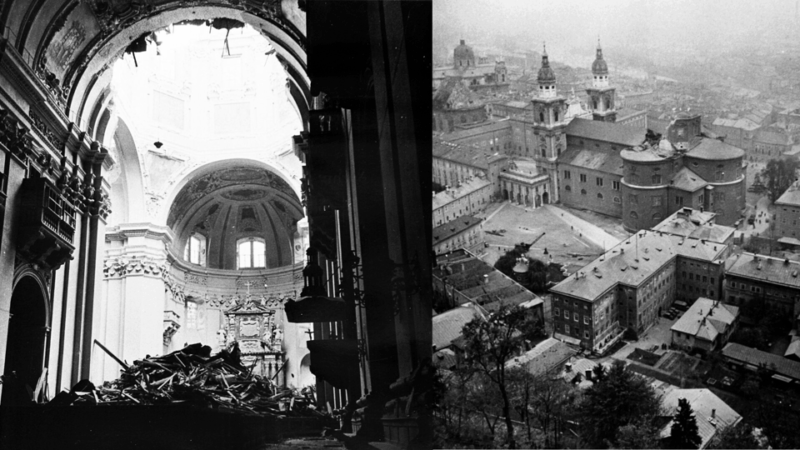
Sabine Rath, an official Austria Guide, leads the tour and provides immersive storytelling about Salzburg’s World War II history. Photographic documentation of wartime destruction, including bomb craters and damaged buildings, offers a visual glimpse into the city’s harrowing past. Plus, the tour delves into the strategic importance of Mönchsberg during the conflict, highlighting its role as a key defense point.
| Wartime Challenges | Salzburg’s Response | Lasting Impacts |
|---|---|---|
| Widespread damage | Resilience and rebuilding | Scars on the cityscape |
| Military occupation | Adaptation and resistance | Altered social dynamics |
| Disruption to daily life | Community solidarity | Enduring memories |
| Economic hardship | Resourcefulness and innovation | Lessons for the future |
| Psychological trauma | Coping mechanisms and healing | Reflections on humanity |
Key Locations Visited
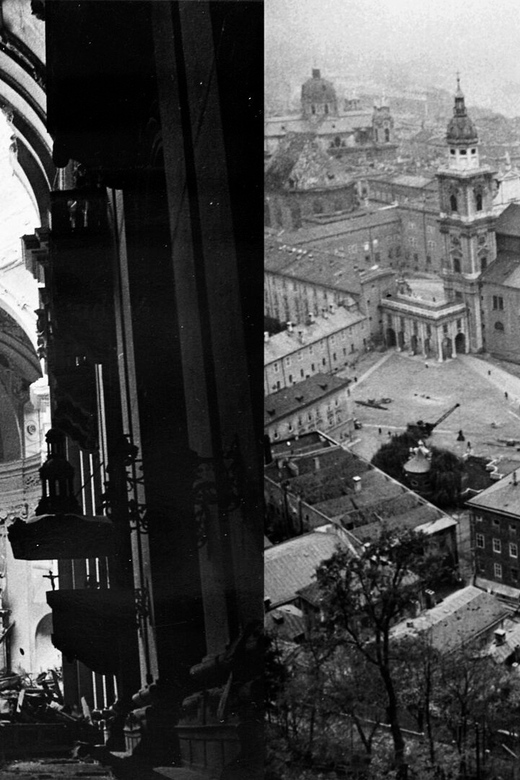
The tour begins at Mozartplatz, the former headquarters of the United States Forces Austria (USFA) during the post-war occupation of Salzburg.
From there, the group heads to Kapitel Square, where they can view the Hohensalzburg Fortress and learn about the severe damage sustained by the Salzburg Cathedral during the war.
Next, they explore the bunker ruins near Mönchsberg, a key defense point for the Nazis.
The tour then takes them to the Pferdeschwemme, which housed a military hospital and mine during the conflict.
More Great Thing To Do NearbyWartime Ruins and Damage
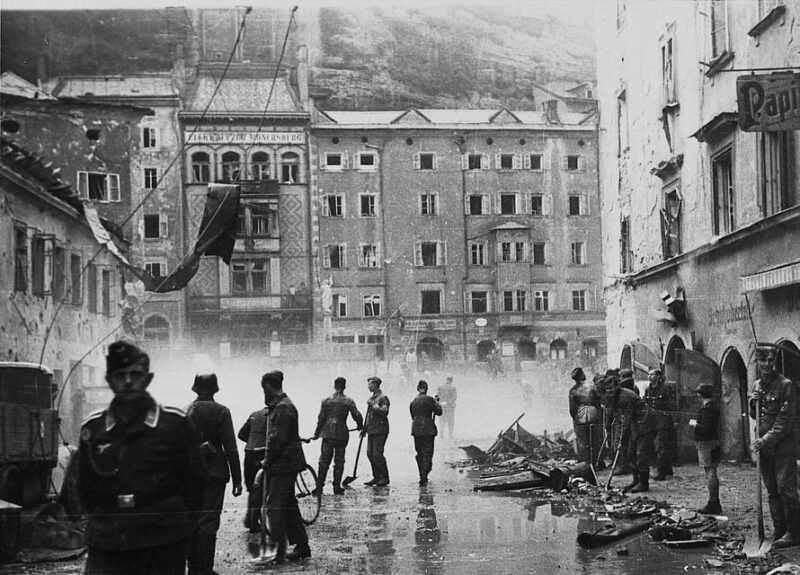
As the tour progresses, visitors are struck by the haunting remnants of Salzburg’s war-torn past.
Standing in Kapitel Square, they gaze upon the battered Salzburg Cathedral, its once-grand façade scarred by the ravages of aerial bombardment. Historical photographs vividly document the cathedral’s severe damage, a stark contrast to its current restored splendor.
Further exploration leads the group to the Mönchsberg, where the crumbling ruins of wartime bunkers serve as a somber reminder of Salzburg’s strategic importance during the conflict. Visitors can imagine the chaos and destruction that once unfolded in these underground fortifications, a chilling glimpse into the city’s darkest chapter.
These tangible reminders of the past lend an air of solemnity to the tour, underscoring the resilience of Salzburg in the face of war.
- The Original Sound of Music Tour in Salzburg
- Salzburg Sightseeing Day Trip From Munich by Rail
- Austrian Apple Strudel Cooking Class Including Lunch in Salzburg
- Salzburg: Palace Concert at the Marble Hall of Mirabell Palace
- Salzburg and Lake Region Small-Group Day Trip From Vienna
- Salzburg Oldtown: Sightseeing Walking Tour With Licensed Local Guide
Strategic Importance of Mönchsberg
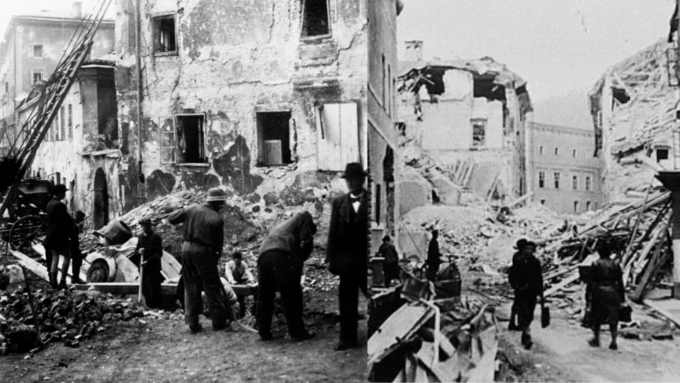
Perched atop the Mönchsberg, the former bunkers and defense structures highlight Salzburg’s strategic importance during the war years. This elevated vantage point afforded commanding views of the city, making it a crucial location for military operations and surveillance. Visitors can still explore the crumbling remnants of these underground fortifications, which once served as a stronghold against potential enemy advances.
| Mönchsberg’s Role | Defensive Fortifications | Surveillance Capabilities | Military Significance |
|---|---|---|---|
| Elevated position overlooking Salzburg | Extensive network of bunkers and underground structures | Panoramic views of the city and surrounding area | Critical for monitoring and responding to enemy movements |
The strategic value of Mönchsberg was undeniable, as it allowed Salzburg’s defenders to maintain a vigilant watch over the city and coordinate their efforts to protect it from harm.
American Memorial Plaque

Visitors can find the American memorial plaque that commemorates the end of the war in Salzburg on May 4, 1945. It stands at the Toscanihof, a poignant reminder of the city’s liberation from Nazi occupation.
The plaque honors the American troops who fought to free Salzburg from the grip of the Third Reich. During the tour, guests will learn about the strategic importance of the Mönchsberg and the pivotal role it played in the city’s defense.
The plaque serves as a solemn tribute to the sacrifices made by American soldiers, whose bravery and determination brought an end to Salzburg’s wartime suffering.
Significance of Salzburg Festival
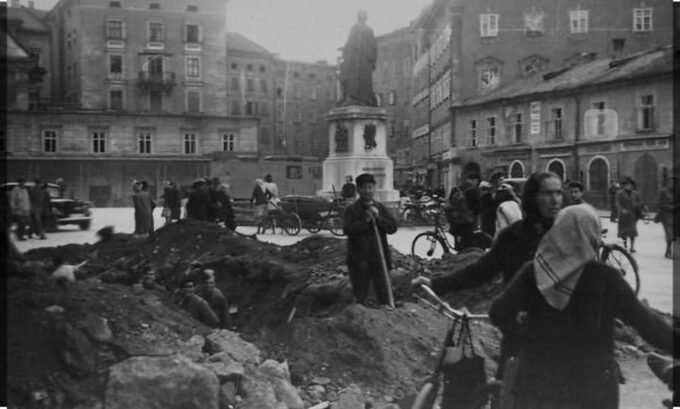
The Salzburg Festival, a renowned classical music event, held immense significance during World War II, as it served as a symbol of cultural resilience in the face of adversity.
Despite the chaos and destruction of the war, the festival continued to take place, offering a much-needed respite for both the local population and the international audience.
The performances were a testament to the enduring power of art and its ability to bring people together, even in the darkest of times.
The festival’s survival was a triumph of the human spirit, and its impact on the cultural landscape of Salzburg during the war years can’t be overstated.
Frequently Asked Questions
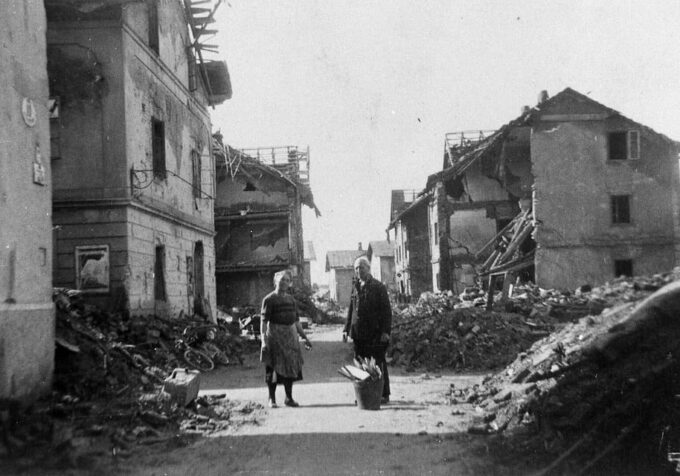
Were Any Salzburg Citizens Killed During the Allied Bombings?
Yes, some Salzburg citizens were killed during the Allied bombings of the city during World War II. The bombings caused significant damage and loss of life among the civilian population, though the exact number of casualties is not provided.
Did the Nazis Take Any Cultural Artifacts From Salzburg?
Yes, the Nazis did take cultural artifacts from Salzburg during World War II. They looted numerous artworks, sculptures, and other valuable items from churches, museums, and private collections throughout the city as part of their systematic plundering of European cultural heritage.
How Did the Salzburg Festival Survive the War Years?
The Salzburg Festival managed to survive the war years by continuing its operations, albeit on a reduced scale. Despite the challenges, the festival maintained its focus on classical music and opera, providing cultural respite during the tumultuous times.
Were There Any Resistance Efforts Against the Nazi Occupation?
Yes, there were resistance efforts against the Nazi occupation in Salzburg. Locals formed underground groups that engaged in acts of sabotage and distributed anti-Nazi propaganda. However, the Nazi regime quickly suppressed these resistance activities.
Were Any Allied Soldiers Killed or Wounded in the Defense of Salzburg?
Allied soldiers faced resistance as they defended Salzburg from the Nazis. While the exact number of casualties is unknown, historians believe several Allied troops were killed or wounded in the fierce fighting to liberate the city in the final days of the war.
Sum Up
The ‘Salzburg in the Shadow of War‘ tour offers a poignant exploration of the city’s tumultuous past during World War II.
Visitors uncover the lasting impact of aerial bombings, Nazi defenses, and the resilience of the Salzburg Festival, which persisted despite the chaos.
Memorials, like the plaque at Toscanihof, honor the sacrifices made during the city’s journey from devastation to liberation and recovery.
You can check if your dates are available here:More Tour Reviews in Salzburg
- Grossglockner Glacier – Highest Mountain in Austria – Private Tour From Salzburg
- Best of Mozart Concert at Fortress Hohensalzburg With Amphibious Splash Tour
- Private Christmas Market Tour in Salzburg
- Fun & Mobile Puzzle Rally Tour Through Salzburg
- Munich Highlights Private Tour From Salzburg by Car
- Eagles Nest Discovery: Salzburg Private Tour With Driver & Guide
Not for you? Here's more things to do in Salzburg we have recnetly reviewed
- 3 Best Shopping Tours In Salzburg
- 11 Best Christmas Experiences In Salzburg
- 7 Best Cruises And Boat Tours In Salzburg
- 5 Best Food Tours In Salzburg
- 4 Best Full-Day Tours In Salzburg
- 12 Best Dining Experiences In Salzburg
- 12 Best Dinner Tours In Salzburg
- 3 Best Lunch Experiences In Salzburg
- Private Transfer From Prague to Salzburg With 2h of Sightseeing, Local Driver
- Relive the Movie Private Sound of Music Tour in Salzburg
- Private Salzburg Day Trip From Vienna
- Sightseeing Transfers From Vienna to Salzburg With a 4-Hours Stop in Hallstatt
